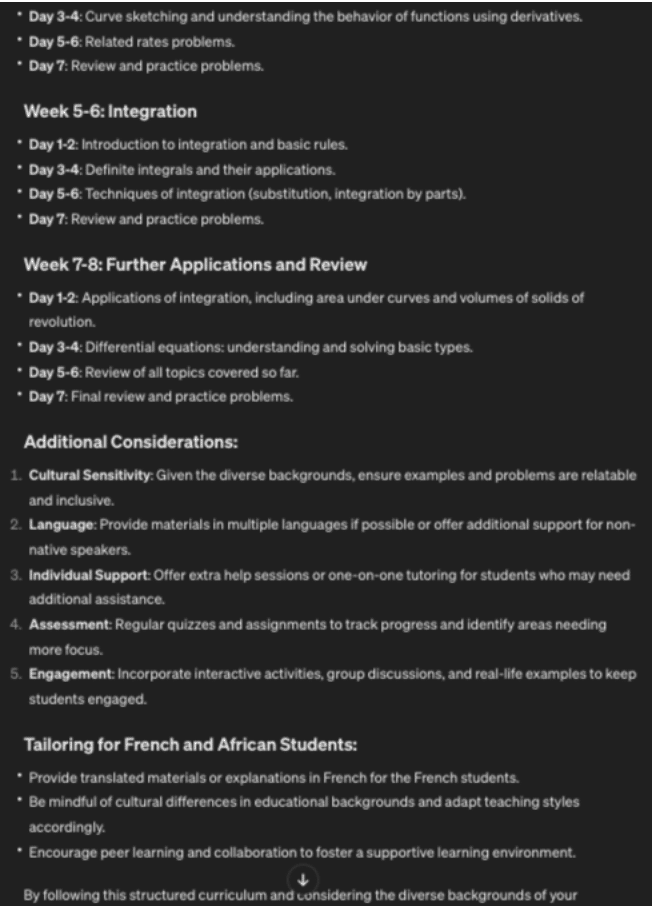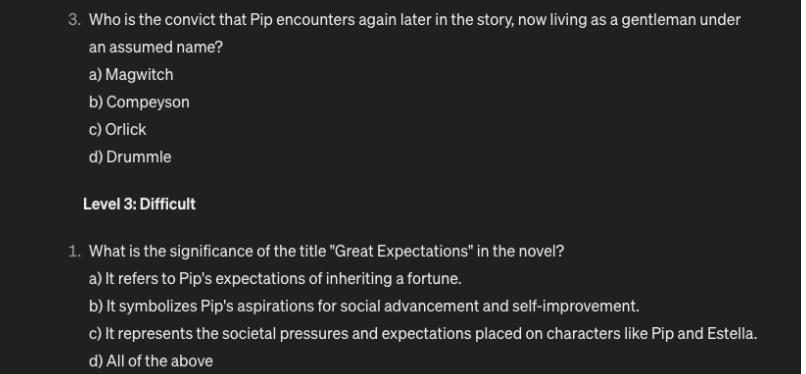Are you providing the best teaching experience to your students? Or is there a slight chance you might be lagging in bringing the best of them? ChatGPT for teachers has become an indispensable tool in 2024 who simply don’t like to compromise with their teaching.
Before you decide on the idea of integrating AI into your way of teaching, give it a thought. Whether you are a primary school teacher or a university professor, bringing the best of your students is essential. About 40 % of teachers are using this tool on a weekly basis and 10 % daily, according to a recent study.
Being a tutor myself who uses this tool regularly, I have formed a comprehensive guide for teachers who want to make their teaching process easier for their students and provide them with the best. (No compromises) Read on, and let’s talk about how you can use this tool to make your teaching personalized and more effective.
How Can Teachers Use ChatGPT?
You might be a pretty fun and relatable teacher who is loved by all in their class of tens of students. So it’s a valid question. How could ChatGPT possibly improve your teaching methods? It all gets pretty standardized after decades of teaching experience.
As the Greek philosopher Heraclitus of Ephesus once said, “The only constant in life is change,” it’s time for some experiments for us as well.
1. Lesson Planning, Curriculum Development, And Classroom Management
ChatGPT can assist you in generating lesson plans by providing ideas, resources, and suggested activities. What is it based on? — The prompts you provide by helping it understand your student’s needs.
You need to make your prompt as extensive as possible. Here is one that I experimented with initially.
Prompt Used: Imagine you are a Junior High tutor for a class of 15. I am revising my curriculum for Calculus [Let’s say] and need to cover all the basics in two months before their tests. 3 of my students are from… [I went on explaining the background of my students]
Here Is What ChatGPT Gave Me.

If not anything, at least you will be able to assess whether your teaching methods are effective and individualized or not.
To make further use of it, after taking the assessments, I shared the results with ChatGPT and tried to understand how I could be more attentive to everyone equally and improve their overall averages. It worked fine for me.
Professor at Universidade da Coruña in Spain, Fran Bellas, uses ChatGPT to craft quizzes, exams, and class lesson plans.
2. Creation Of Assessments, Quizzes, And Educational Materials
The more effectively you can delegate your work, the more attentive you will be to each student. It’s as simple as that. ChatGPT can generate assessments, quizzes, and other educational materials.
It can provide question types, like multiple-choice, short-answer, and essay questions. You just need to elaborate on the prompt you put in. (That’s the game changer)
I gave ChatGPT this prompt, “I need to prepare a quiz covering Great Expectations by Charles Dickens. It needs to have levels of questions, from easy to difficult. Help me prepare one.”
Here Is What I Got:

This is the beauty of ChatGPT. It reduces your research time significantly. You can ask it to mold the questions, prepare 50 more, or however you may please. It’s there for you!
With the time I save, I think more about how to shape this output in a way that helps my students learn better and retain the concepts. (ChatGPT can be helpful there as well.)
3. Useful For Non-Native Speakers In Translation
I had a student from Bangladesh last year, and I had a feeling I wasn’t the best for him. (He had some difficulty with English) I was extra attentive, but of course, my teachings and his ability to understand differed. The communication barrier was there.
So I asked ChatGPT this, “I have a student from Bangladesh who doesn’t have a firm grasp of English. How can I help him better understand 8th-grade literature?”

This part of ChatGPT’s answer changed the way how I approached the subject. I wasn’t doing it well while treating my students equally. A teacher’s job is to ensure equity, not equality. We need to find ways to understand them better and give them ways to push themselves.
Pros And Cons Of Using ChatGPT As A Teacher
Any additions to your teaching method need to be used wisely, as it’s evidently not all glitz and glamor. Think about being overtly reliant on a tool like ChatGPT that’s far from perfect.
We need to understand how, where, and in what ways this tool can be used.
Pros
- Improves Accessibility
As I mentioned before, this is OpenAI and is inclusive and accessible. That’s one of the main values of this system. You can use it for translation or helping students with disabilities.
- Personalized Support
ChatGPT can adapt to individual students’ needs and offers customized explanations. You can use it to make your subject as understandable as possible to students with different requirements during your presentations.
- Helps With Homework
ChatGPT can help your students save time and help them complete assignments more easily. You can guide them on how to use it effectively.
When students ask ChatGPT questions, it answers them elaborately and gives easy examples. In turn, it helps them retain better.
- Exam Preparation
You can ask ChatGPT to reschedule the course and revision modules. To shorten the explanations from the bookish, lengthy ones, you can ask it to make it more understandable and concise. Your PPTs can become more powerful that way.
- Makes Learning Fun
One of the best aspects of ChatGPT is it makes learning a bit more fun. Try prompts where you ask it to be funny or engaging. You can be creative and ask it to create analogies in nutrition and other difficult subjects.
Cons
- Accuracy and Reliability
ChatGPT does not always provide accurate or reliable information. Its knowledge related to real-time and latest scenarios is restricted. There is a risk of misinformation or incomplete explanations. It is far from completely reliable.
- Lack of EI
ChatGPT lacks the empathy and understanding that we human teachers offer. It does not personalize guidance and modules the way we can. You still need to do your job and make learning humane.
- Dependency
Over-reliance on ChatGPT can easily discourage critical thinking and independent problem-solving skills in students. This can be the case for both teachers and students.
If your students provide answers completed by ChatGPT, it’s not helping them. We need to use it as a learning tool, not make us lazy. The same goes for teachers who are making ChatGPT-based presentations. That’s not helping anyone! And worse, is perhaps teaching them wrong things.
Make Full Use of ChatGPT As A Teacher
Before you start using ChatGPT and get irked by generic responses, it is important to understand how to write good prompts.
Good Prompt: “Can you explain the concept of photosynthesis in simple terms?”
- This prompt is clear, specific, and aligned with what you want ChatGPT to do. It gives it the language usage type as well.
Bad Prompt: “Tell me about plants.”
- This prompt is too broad and vague. The result? A generic answer related to plants. (Which you definitely didn’t want.)
Good Prompt: “Can you provide an example of a metaphor used in Shakespeare’s sonnets?”
- This prompt is focused on helping ChatGPT demonstrate an understanding of literary devices. You can be even more specific and point out its plays and what sorts of metaphors you are looking for.
Bad Prompt: “Talk about Shakespeare.”
- This prompt lacks specificity and may result in a generic response. You will simply learn he was a great writer.
The key to good and specific answers? Good and specific prompts.
Teach Students When And How To Use ChatGPT
After you have spent enough time understanding ChatGPT yourself, you can start teaching your students how to use it in their lives. Because, believe it or not, they are (probably) using it already.
One-third of students are already using this revolutionary tool. It is exactly the high school scenario where before your kid gets into hard drugs, he should feel comfortable enough talking about smoking cigarettes with you. Are you providing your students with that comfort zone?
So, it’s best to address the elephant in the room and help them learn how to use it.
1. Ethics
Make some rules related to the use of ChatGPT, such as how much and in what ways it is allowed. Can they use it in the classroom? If at home, for what purpose? The more clear the guidelines, the better.
2. When Is It Okay To Use ChatGPT?
If they do not understand a particular topic, encourage them (And even teach them) how they can learn through it in simple language. Just like Google, it’s a great platform to learn things from.
3. Cheating Rules
If your students are simply copying and pasting their homework from ChatGPT, you need to talk with them. Test their knowledge and help them understand the relevance of their homework. You need to create strict rules related to teaching.
The more I used this platform, the better I could detect the AI language pattern in my students’ homework.
4. Verifying Information
Teach students to evaluate information obtained from ChatGPT and verify sources for accuracy. Help them understand the importance of citing their work. (And no, they cannot cite ChatGPT)
5. Sharing Sensitive Information
It’s highly important to teach students not to share any sensitive information with ChatGPT and to teach them how to use this tool mindfully. Talk to them about the dangers of sharing personal things with ChatGPT or being over-reliant.
Future Of OpenAI
In 2024 and beyond, AI will become more and more of an indispensable part of our teaching and students’ learning patterns. So yes, it’s most likely not going anywhere.
- OpenAI is likely to become more sophisticated and versatile.
- OpenAI is bound to be integrated with augmented reality (AR), virtual reality (VR), and immersive learning platforms. (It can already understand videos.)
In the future, we may be conducting virtual sessions while putting our VR sets on the heads and teaching in virtual classrooms.
- It will become more and more personalized. Perhaps with the advent of Neuralink technology, it will be able to understand students better than themselves.
If you want to learn more about where the future is heading, be sure to check this out or this community page. It will not only help you be aware, but you can also talk about these possibilities with the students. They always bring several interesting insights during these discussions.
More On ChatGPT
Conclusion: ChatGPT Can Save Significant Time With Correct Integration
Can ChatGPT be your companion in making your teaching more efficient and personalized? Yes. Is it completely reliable? No.
As OpenAI is bringing new versions of ChatGPT, likely, its integration in teaching is only going to become more evident and omnipresent. So go on and delegate your tasks, help students use it ethically, and allow yourself to be a better teacher.
Play with different prompts, use this revolutionary technology safely, and become the best teacher. (Spoiler Alert: You already are.)
Article By

